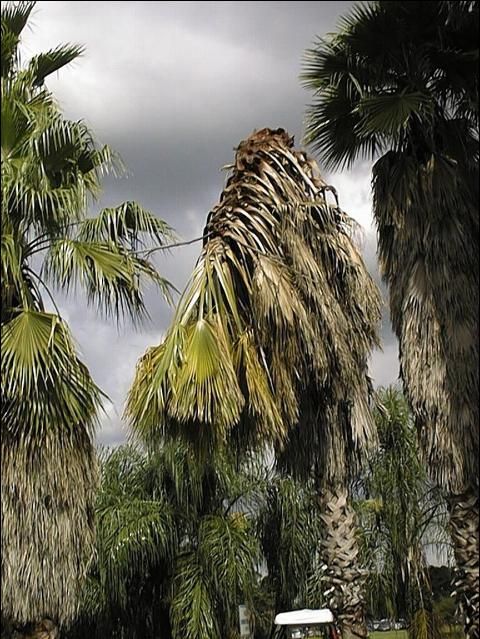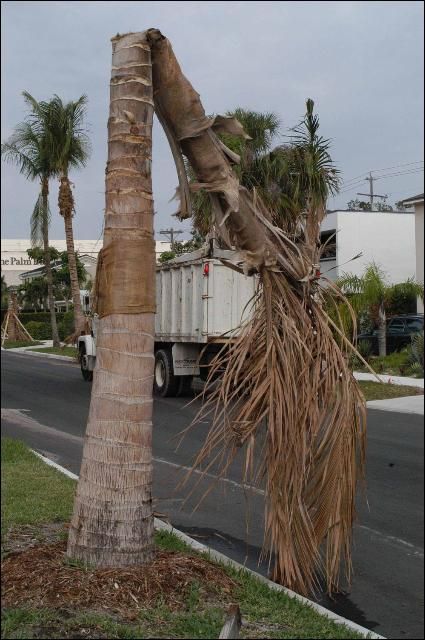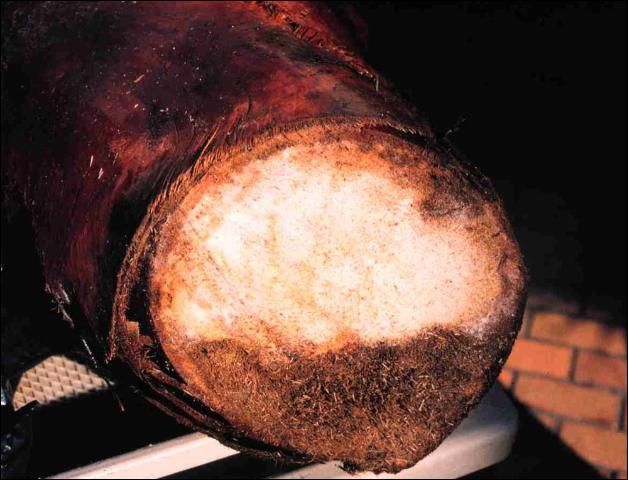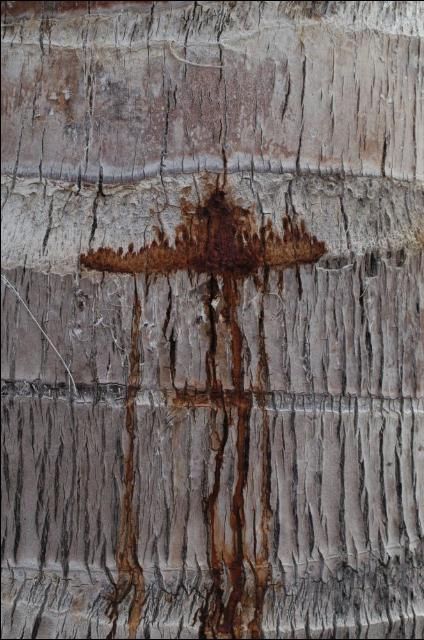Summary
- Thielaviopsis trunk rot is caused by the fungus Thielaviopsis paradoxa.
- Due to this disease, the palm trunk either collapses on itself or the canopy suddenly falls off the trunk, often without warning. The palm canopy may appear healthy prior to collapse.
- Except for stem bleeding, which is common in Cocos nucifera (coconut), there may be no symptoms prior to collapse of the palm.
- Only fresh trunk wounds will become infected by the fungus, so disease management includes limiting man-made wounds to the palm trunk, especially the upper third of the trunk.
- There are no methods to prevent or cure this disease. The palm should be removed immediately and the diseased trunk portion destroyed but not recycled.
Introduction
Thielaviopsis paradoxa is a fungus that can infect any part of a palm and so can cause numerous diseases. In Florida, the two most frequent (and usually lethal) Thielaviopsis diseases observed in the landscape and field nursery are a bud (heart) rot and trunk rot. Thielaviopsis bud rot is discussed at https://edis.ifas.ufl.edu/pp144.
Pathogen and Hosts
Thielaviopsis paradoxa is a fungus with many names. Its asexual-stage name has changed from Thielaviopsis to Chalara and, more recently, back to Thielaviopsis. It is this stage that is most often encountered. The fungus produces two different types of asexual spores, endoconidia and chlamydospores. The latter will survive for long periods in the soil. The fungus also has a sexual-stage name of Ceratocystis paradoxa. This stage is rarely observed in natural settings.
Thielaviopsis paradoxa appears to only be able to infect a palm when a fresh wound is present. Most infections occur in non-lignified or lightly lignified tissue. The fungus often, but not always, produces volatile substances, specifically ethyl acetate and ethyl alcohol, which give the diseased tissue a fermented fruit odor.
While this fungus is found throughout the world, its host range is primarily restricted to monocot plants grown in warm climates. Besides palms, the fungus causes diseases of banana, pineapple, and sugarcane. While the fungus has not been reported on every palm species grown in the landscape, all palm species are considered potential hosts for this fungus.
Symptoms
As indicated previously, this fungus prefers to degrade (rot) non-lignified or lightly lignified plant tissue. Since the greatest number of lignified fibers are in the lower trunk and the least number in the upper trunk, this disease is most often observed in the upper third of the trunk. While there are no reliable symptoms that can be used to predict which palms are infected with Thielaviopsis paradoxa and which ones are not, two symptoms that might be observed include the lowest leaves dying prematurely and hanging down from the canopy and "stem bleeding." Unfortunately, there often are no visible indications that a palm has Thielaviopsis trunk rot until either the trunk collapses on itself (Figures 1 and 2) or the canopy suddenly falls off the trunk (Figure 3). The canopy often appears normal and healthy.

Credit: F. W. Howard

Credit: M. L. Elliott, UF/IFAS

Credit: H. Donselman
In the situation where the canopy falls off the trunk, the rot occurs below the bud at the base of the canopy in the woody tissue. This is also an area with little, if any, lignified plant tissue. When the trunk rot is farther down the trunk, this means that the fungus has rotted the trunk tissue until the palm can no longer structurally support itself. Examination of a cross-section through a diseased trunk illustrates that the rot is located only on one side of the trunk (Figures 4 and 5). This is in contrast to Ganoderma butt rot, in which the fungus is at the trunk base and rots from the center of the trunk to the outside. Ganoderma butt rot is discussed at https://edis.ifas.ufl.edu/pp100.

Credit: M. L. Elliott, UF/IFAS

Credit: M. L. Elliott, UF/IFAS
Stem bleeding is a common symptom of Thielaviopsis trunk rot observed on Cocos nucifera (coconut). This stem bleeding is a reddish-brown or brown or black stain that runs down the trunk from the point of infection (Figure 6). Since any trunk wound may result in stem bleeding, close examination of the point of infection is required. If the stem bleeding is due to Thielaviopsis paradoxa and the disease has progressed significantly, the tissue immediately surrounding the wound (infection point) will be quite soft in comparison to surrounding trunk tissue. You will be able to push your finger past the pseudobark and into the truck tissue. Palms other than coconuts, especially those with a smooth trunk, may also exhibit stem bleeding, but it seems to be most common in coconut. Eventually, the trunk will collapse on itself at the point of infection. Because the fungus cannot degrade lignin, the trunk fibers are left nearly intact, while the tissue surrounding the fibers is degraded, resulting in "stringy" black tissue (Figure 7).

Credit: M. L. Elliott, UF/IFAS

Credit: M. L. Elliott, UF/IFAS
Diagnosis
The exact diagnosis of this disease is based on identification of the fungal pathogen from the diseased trunk tissue. It is usually not possible to determine the pathogen without examining the fungal spores. These may be examined directly on the plant tissue, if spores are being produced. Isolation of the pathogen can be made on artificial media and this growth then observed for spores.
Note that trunk tissue will be required for fungal isolation and identification. The leading edge of the rotted trunk tissue is the best material for success in this endeavor. Older, rotted trunk tissue is likely to have secondary fungi and bacteria present, which complicate, and sometimes prevent, the isolation of Thielaviopsis paradoxa.
The Florida Extension Plant Disease Clinic (FEPDC) network is available for pathogen identification. Contact your local UF/IFAS Extension office or FEPDC for details on sample submission and cost of the laboratory diagnosis.
Disease Management
Thielaviopsis trunk rot usually occurs quite randomly, with only a few palms in the landscape being affected. However, there are situations where high numbers of palms in a single landscape can become diseased, for reasons that are not always clear. In all situations, there has to be a fresh wound to the palm. Wounds can occur naturally, such as trunk cracks due to excess water uptake. Insects (such as ambrosia beetles), birds (sapsuckers pounding on the trunk), rats, and other mammals can cause wounds. Blowing objects during a wind storm can strike a trunk and cause a fresh wound. Humans cause wounds with nails and climbing spikes or during the digging and transplanting process.
Humans also create wounds when trimming leaves that are not yet dead. Leaf petioles are cut as close as possible to the trunk. If a leaf petiole has any green color associated with it, the leaf is still living. When that still living petiole is cut, a fresh wound is created that may be infected by the fungus. Trunks can be easily wounded during the trimming process with the careless use of the pruning tool. Pulling a leaf off the trunk when the leaf petiole still has green tissue can create a fresh wound.
The fungal pathogen can spread from palm to palm as follows. First, if spores are produced on diseased palm tissue, these spores can be moved by wind and water to fresh wounds. The spores may also be moved about by insects or rodents. Second, the chlamydospores are spores that can survive in the environment, especially soil, for long periods. Fresh wounds could become infected via contaminated soil.
Except for stem bleeding, there are often no outwardly visible symptoms that indicate which palm in the landscape or field nursery has Thielaviopsis trunk rot. Thus, there are no proven strategies for preventing this disease. Once the palm has collapsed, remove it immediately as it is a source of fungal spores. It is acceptable to plant a palm back into the same location, but do so with caution. Minimize trunk wounds and keep the upper half of the trunk from contacting the soil.
Ideally, only prune dead leaves from the canopy. Otherwise, when pruning palms, disinfecting tools or using a new tool or blade for each palm may be useful in disease prevention. Examples of disinfectants include: 1) 25% chlorine bleach (3 parts water and 1 part bleach); 2) 25% pine oil cleaner (3 parts water and 1 part pine oil cleaner); 3) 50% rubbing alcohol (70% isopropyl; equal parts alcohol and water); 4) 50% denatured ethanol (95%; equal parts alcohol and water); 5) 5% quatenary ammonium salts. Soak tools for 10 minutes and rinse in clean water.
Diseased trunk material should be destroyed and should not be recycled in the landscape. Chipping and then spreading the infested material in the landscape could spread the fungus to healthy palms. If the trunk is chipped, it should be placed in a properly constructed and monitored compost heap, or taken to a landfill or incinerator.
Selected References
Paulin-Mahady, A. F., T. C. Harrington, and D. McNew. 2002. "Phylogenetic and taxonomic evaluation of Chalara, Chalaropsis, and Thielaviopsis anamorphs associataed with Ceratocystis." Mycologia 94: 62–72.
Simone, G. W. 2004. "Thielaviopsis diseases." In Compendium of Ornamental Palm Diseases and Disorders. edited by M. L. Elliott, T. K. Broschat, J. Y. Uchida, and G. W. Simone, 37-38. St. Paul, MN: American Phytopathological Society.
Wingfield, M. J., K. A. Seifert, and J. F. Webber, eds. 1993. Ceratocystis and Ophiostoma: Taxonomy, Ecology, and Pathogenicity. St. Paul, MN: American Phytopathological Society.